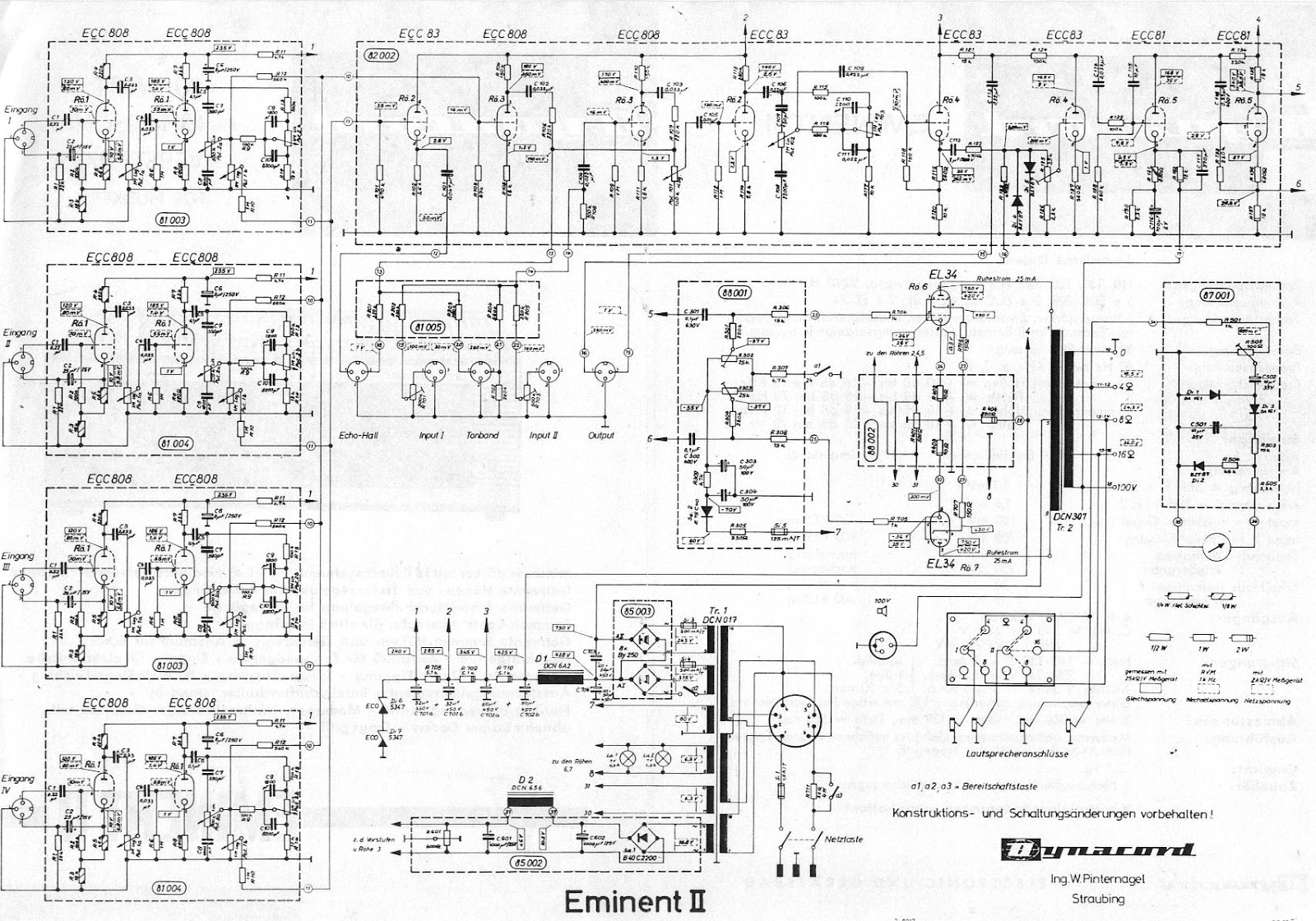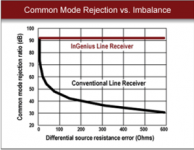Would someone kindly explain the difference between Balanced & Unbalanced inputs/ouputs?
With thanks
With thanks
Balanced means balanced impedance
The impedance of the two input lines (or the two output lines) is equal with respect to the Ground/Earth/Reference.
Unbalanced means unbalanced impedance where the two inputs are at different impedances with respect to the Ground/Earth/Reference.
Impedance in the above, means the reactive as well as the resistive impedances. All should be made as equal as possible for an excellent balanced impedance connection.
The impedance of the two input lines (or the two output lines) is equal with respect to the Ground/Earth/Reference.
Unbalanced means unbalanced impedance where the two inputs are at different impedances with respect to the Ground/Earth/Reference.
Impedance in the above, means the reactive as well as the resistive impedances. All should be made as equal as possible for an excellent balanced impedance connection.
In telecommunications and professional audio, a balanced line or balanced signal pair is a transmission line consisting of two conductors of the same type, each of which have equal impedances along their lengths and equal impedances to ground and to other circuits.
What is the difference between balanced or unbalanced? Balanced audio uses three conductors to carry the audio signal. Two of the conductors carry negative and positive signals (audio is an AC signal), and the third is used for grounding. ... One carries positive, the carries negative and is also used for ground.
In electrical engineering, an unbalanced line is a transmission line, often coaxial cable, whose conductors have unequal impedances with respect to ground; as opposed to a balanced line. Microstrip and single-wire lines are also unbalanced lines.
What is the difference between balanced or unbalanced? Balanced audio uses three conductors to carry the audio signal. Two of the conductors carry negative and positive signals (audio is an AC signal), and the third is used for grounding. ... One carries positive, the carries negative and is also used for ground.
In electrical engineering, an unbalanced line is a transmission line, often coaxial cable, whose conductors have unequal impedances with respect to ground; as opposed to a balanced line. Microstrip and single-wire lines are also unbalanced lines.
Thanks.
I'm only interested in audio connections...
So why and when should a Balanced connection be used against an Unbalanced?
I'm only interested in audio connections...
So why and when should a Balanced connection be used against an Unbalanced?
Jon: You have fallen into the balanced vs differential trap. You can have unbalanced differential feeds. Balanced can be hot and zero. Current will flow equally in both, but voltages will be different.
Bruno Putzy's 'The G-word' is a great primer on this. available free from your friendly internet.
Bruno Putzy's 'The G-word' is a great primer on this. available free from your friendly internet.
I don't wish to be ungrateful but....
Why and when should a Balanced connection be used against an Unbalanced connection?
Why and when should a Balanced connection be used against an Unbalanced connection?
Not disagreeing but:Balanced means balanced impedance
The impedance of the two input lines (or the two output lines) is equal with respect to the Ground/Earth/Reference.
Unbalanced means unbalanced impedance where the two inputs are at different impedances with respect to the Ground/Earth/Reference.
Impedance in the above, means the reactive as well as the resistive impedances. All should be made as equal as possible for an excellent balanced impedance connection.
balanced mainly means balanced *signal* so at the far end a differential amplifier can recover clean signal (and turn it into unbalanced) ; balanced impedance is good but not indispensable.
FWIW lots of early balanced microphone inputs did NOT show same impedance to each half of the signal, yet worked surprisingly well canceling unwanted hum and noise, the main object.
Among others, you would find them in Dynacord microphone inputs and many Italian PA mixers.
Typically + signal went to base and - signal to emitter, but here you have an even more extreme version, I can´t imagine a more unbalanced *impedance* stage than one which feeds + signal to tube grid and - signal to tube cathode


Last edited:
I don't wish to be ungrateful but....
Why and when should a Balanced connection be used against an Unbalanced connection?
For that you need to wade into the work of Bill Whitlock
Links to the Bill Whitlock Papers
This explains far more coherently than any of us can. The short answer is that, for domestic audio with short interconnects it is rarely an audible issue, but if you are after ultimate performance then it has more of an effect than magic cables or flooby dust snake oil.
From WhitlockNot disagreeing but:
balanced mainly means balanced *signal* so at the far end a differential amplifier can recover clean signal (and turn it into unbalanced) ; balanced imoedance is good but not indispensable.
The fact that many have got it wrong does not change what is right!Overview of Audio System Grounding & Interfacing
Bill Whitlock, 9/4/2012
Unbalanced vs Balanced
•
Status depends ONLY on IMPEDANCES with respect to ground of the two signal conductors!
•
In unbalanced interfaces, one impedance is zero (grounded) while the other is significantly higher
•
In balanced interfaces, impedances are equal
EDIT: The THAT corp chart of CMRR vs imbalance is always worth looking at (attached)
Attachments
Last edited:
Balanced impedance connection can have unequal voltages on the two signal wires.
Balanced input reads the DIFFERENCE between the two signal voltages and process that differential voltage. This differential signal could be 2Vac on one line and 0Vac on the other.
Or even 3Vac on one line and 1Vac on the other and just to be different could be an in-phase 1.5Vac on one line and an opposite phase 0.5Vac on the other line. In all three of these examples the DIFFERENCE between the two lines is 2Vac.
But for balance the IMPEDANCES should be near identical.
However, there is differential signalling where the impedance matching is not necessary. In differential signalling ONLY the voltages are important.
Differential signalling is not the same as balanced impedance signalling.
Balanced input reads the DIFFERENCE between the two signal voltages and process that differential voltage. This differential signal could be 2Vac on one line and 0Vac on the other.
Or even 3Vac on one line and 1Vac on the other and just to be different could be an in-phase 1.5Vac on one line and an opposite phase 0.5Vac on the other line. In all three of these examples the DIFFERENCE between the two lines is 2Vac.
But for balance the IMPEDANCES should be near identical.
However, there is differential signalling where the impedance matching is not necessary. In differential signalling ONLY the voltages are important.
Differential signalling is not the same as balanced impedance signalling.
Last edited:
... but all both differential and balanced terminology are often misused in common, non-technical parlance.
And that is what causes difference and people to become unbalanced !
And that is what causes difference and people to become unbalanced !
I Think the main advantage of using a balanced signal is to drive long cables and to reject noise. On a live concert, you have long balanced cables that go from the stage to the mixing desk in the middle of the audience. Try this with RCA cable and all sorts of hum and noise will appear in the PA speakers. The fact is, as you have two signals out of phase in a balanced connection, the positive noise summed with the negative noise induced in the cable will be cancelled or severely attenuated.
Again you have missed the point. The common mode rejection entirely comes from the impedance balance NOT the differential signal. This is a cause of confusion, which is why Putzys and Whitlock are essential reading.
The fact is, as you have two signals out of phase in a balanced connection, the positive noise summed with the negative noise induced in the cable will be cancelled or severely attenuated.
Bit confusing. The 'noise' has to be the same in both signals ie Common Mode.
as there is no difference between the noise signals the Differential input circuit attenuates the noise according to it CMMR.
No. The common mode rejection comes jointly from the impedance balance and the common-mode rejection of the receiver. Get either wrong and you lose common-mode rejection (except in the case where the two errors cancel each other).billshurv said:The common mode rejection entirely comes from the impedance balance NOT the differential signal.
Good common-mode rejection in the receiver means that it only responds to differential mode voltages i.e. the difference in voltage between the two lines. Good impedance balance means that induced common-mode interference currents produce the same voltages across the impedances so the receiver can reject them.
Note that none of this says anything about the quality of the original audio signal. That is the same for balanced and unbalanced. Some believe the myth that balanced circuits somehow give better signal. They do not; they just give less noise and interference, but on short circuits (e.g. most domestic situations) this is irrelevant.
No. The common mode rejection comes jointly from the impedance balance and the common-mode rejection of the receiver. Get either wrong and you lose common-mode rejection (except in the case where the two errors cancel each other).
Yes indeed. But too be fair I think the post quoted was meant to counteract the idea that it is the 'equal and opposite' voltage that gives the benefit. I think the role of the receiver CMRR is sort of assumed. All good though 🙂
Balanced is used for noise rejection. It's nicely effective in electrically noisy environments like live shows. Pro microphones use a balanced signal almost exclusively. Unbalanced works just fine with sort runs, good cables and high signal levels. Unbalanced is cheaper and easier.
I will now let the conversation return to its debate over what is the technically correct terminology. In my 40+ years in pro audio, I've never heard it called anything but balanced.
I will now let the conversation return to its debate over what is the technically correct terminology. In my 40+ years in pro audio, I've never heard it called anything but balanced.
- Status
- Not open for further replies.
- Home
- Source & Line
- Analog Line Level
- Balanced & Unbalanced
